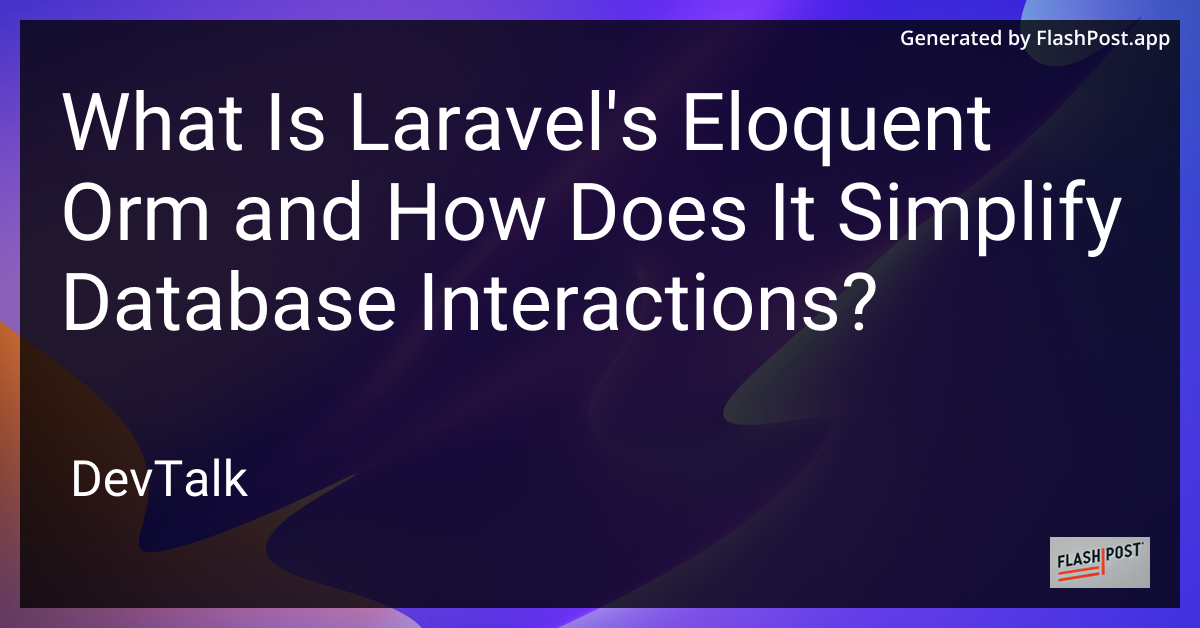What Is Laravel's Eloquent Orm and How Does It Simplify Database Interactions?

Understanding Laravel's Eloquent ORM: Simplifying Database Interactions
Laravel, a prominent PHP framework, is widely acclaimed for its expressive syntax and developer-friendly features.
One of its standout features is the Eloquent ORM, an elegant way of interacting with databases using an ActiveRecord implementation. This article dives into what Laravel's Eloquent ORM offers and how it simplifies database interactions, making it an indispensable tool for developers.
What is Eloquent ORM?
Eloquent ORM (Object-Relational Mapping) is an advanced query builder that allows developers to work with databases more efficiently using PHP's object-oriented syntax. It’s a part of Laravel, designed to alleviate the complexities involved with writing raw SQL queries by representing tables as classes and rows as objects.
Key Features of Eloquent ORM
-
Active Record Implementation: Each database table is represented as a model, enabling developers to interact with the database using object-oriented syntax instead of raw SQL. This makes the process intuitive and more manageable.
-
Elegant and Intuitive: Eloquent provides a rich set of methods for performing common database operations like creating, reading, updating, and deleting records, logically and expressively.
-
Relationships Management: Define relationships between tables effortlessly. Eloquent handles complex SQL operations such as joins, making it straightforward to access associated data across multiple tables.
-
Eager Loading: Improve query performance by loading associated data along with the main object, reducing the number of queries required for data retrieval.
Simplifying Database Interactions
Working with databases often involves repetitive SQL queries. Eloquent ORM simplifies this by offering:
-
Automatic Timestamps: Eloquent can automatically maintain the
created_atandupdated_atfields in your database, saving developers from writing redundant timestamp logic. -
Mass Assignment: This feature allows you to set the attributes of a model all at once, using an array or JSON object, which streamlines data entry processes.
-
Query Scopes: Define common query functions once and reuse them, promoting code reusability and reducing maintenance risk.
-
Model Events: Eloquent provides a suite of events such as creating, updating, deleting, etc., allowing you to hook into various points in a model’s lifecycle to run custom logic.
Eloquent Relationships
Eloquent makes defining relationships between models straightforward. Whether it's one-to-one, one-to-many, or many-to-many, Eloquent covers all bases, enabling more structured and logical database schema representation through relationships.
Example of a One-to-Many Relationship
To define a one-to-many relationship between a User model and Post model:
class User extends Model
{
public function posts()
{
return $this->hasMany(Post::class);
}
}
This allows you to access all of the posts for a given user in an elegant and simple manner:
$user = User::find(1);
$posts = $user->posts;
Links to Relevant Laravel Topics
To further enhance your Laravel applications and ensure best practices, explore these comprehensive guides:
- Learn about Laravel File Caching Restrictions and how to handle caching efficiently.
- Discover steps to Disable Cache in Laravel to optimize performance.
- Understand how to Hide URL Values in PHP Laravel for enhanced security and improved user experience.
- Enhance your Laravel applications with Laravel SEO Optimization techniques.
- Implement user-friendly navigation in your applications using Return Redirect in Laravel Controller.
Conclusion
Laravel’s Eloquent ORM revolutionizes the way developers interact with databases by providing a framework that's both powerful and intuitive. Its ability to simplify complex interactions and streamline databases makes it a crucial part of Laravel development, enhancing productivity and improving code manageability. By mastering Eloquent, you'll unlock a smoother and more scalable way to build robust applications efficiently.